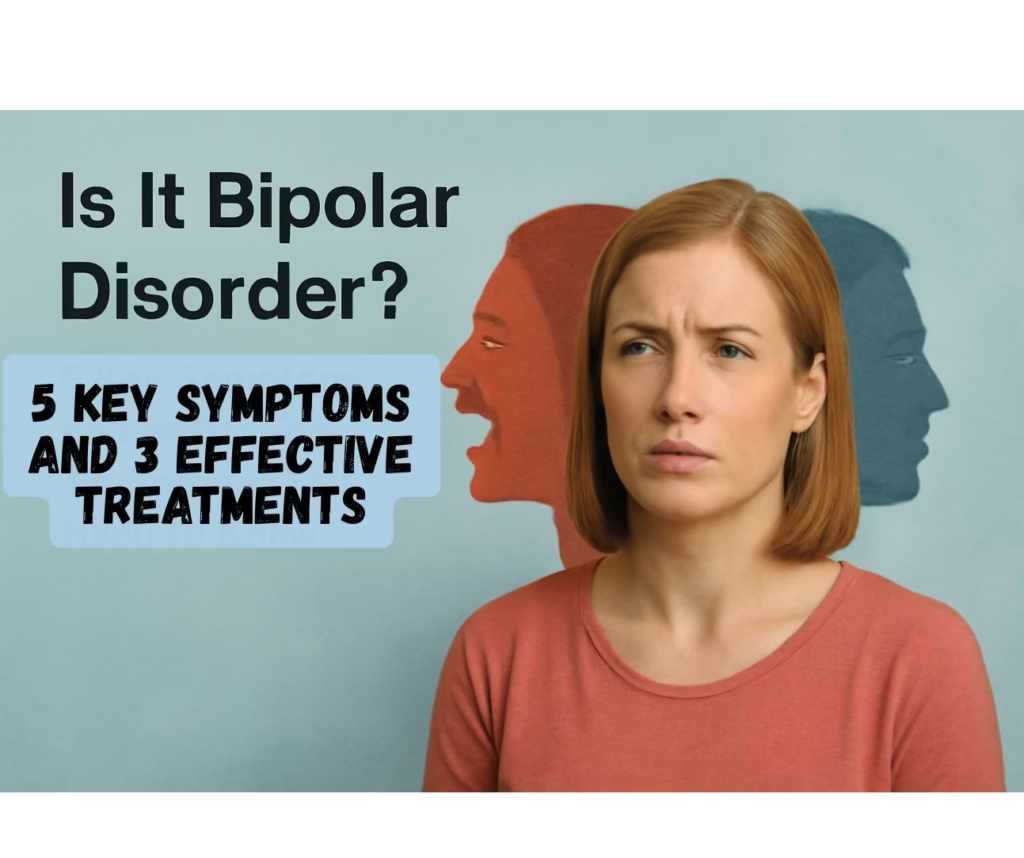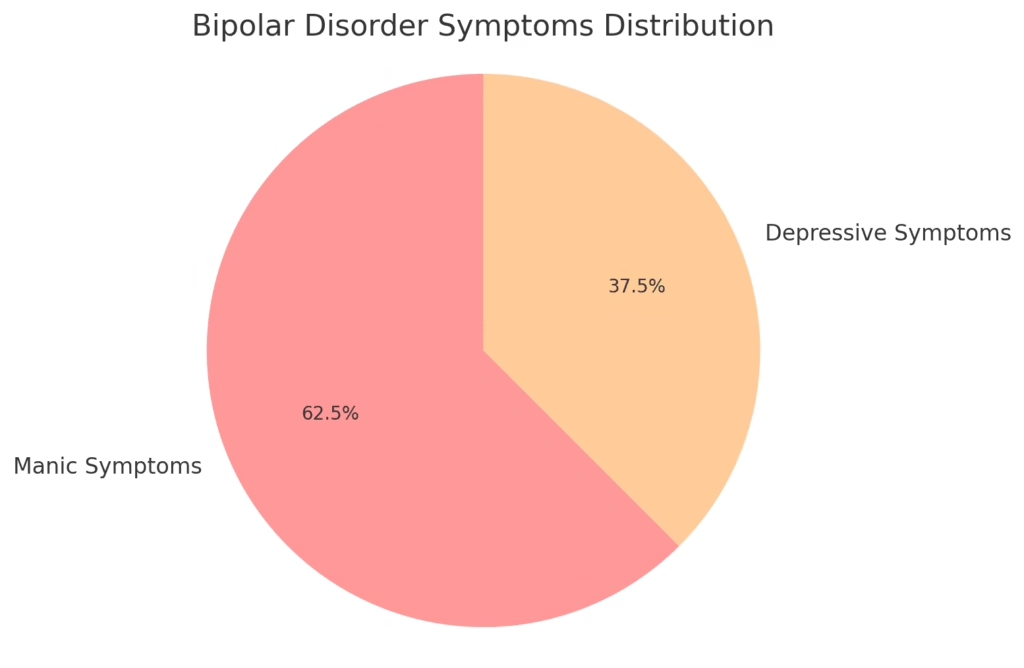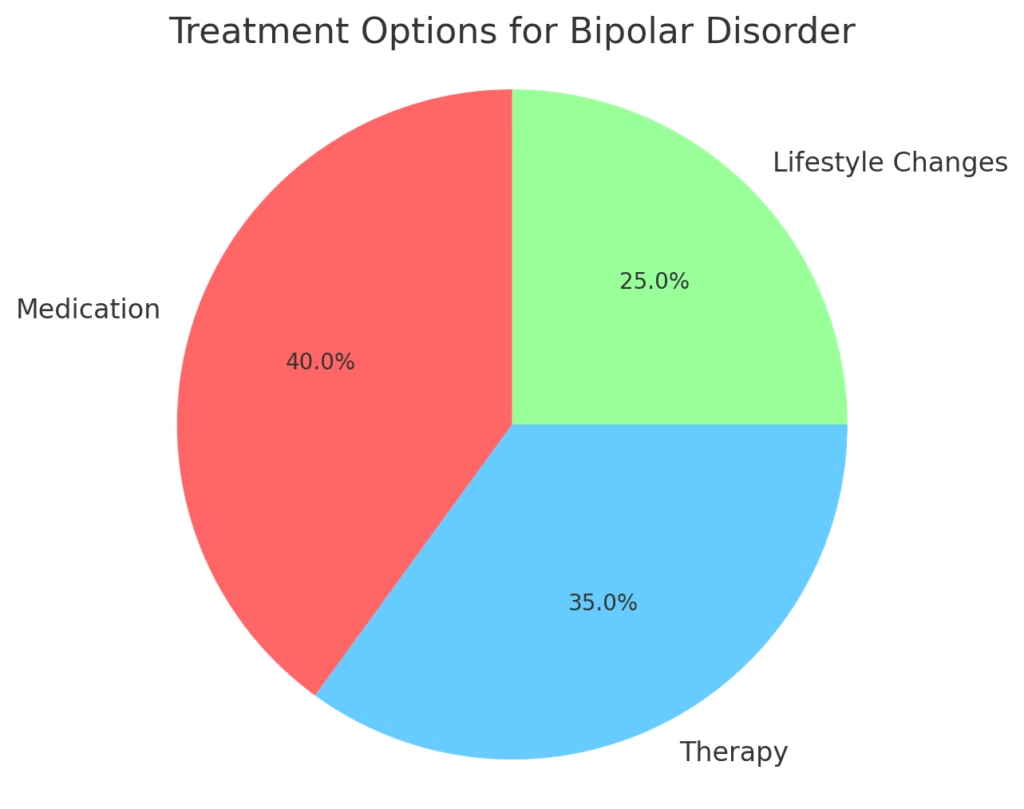
Bipolar disorder is a mental health condition that affects millions of people worldwide. If you’ve ever wondered what bipolar disorder is and how it impacts a person’s life, you’re not alone. Understanding the signs and symptoms is crucial. Recognizing these symptoms can help you or a loved one seek appropriate help.
Understanding Bipolar Disorder: Key Symptoms and Treatments
Bipolar disorder is more than just mood swings. It involves significant changes in energy levels, activity, and the ability to carry out everyday tasks. If you’re asking yourself, “What is bipolar disorder?“, the condition can be broadly categorized into two main types. Bipolar I and Bipolar II both involve extreme mood swings. These swings range between manic highs and depressive lows.

Key Symptoms of Bipolar Disorder
The signs and symptoms of this disorder can vary from person to person. Yet, there are some everyday experiences to be aware of. It’s essential to understand the manic and depressive phases of bipolar disorder. They affect a person’s behavior in distinct ways. They also have a unique impact on a person’s emotional state.
- Manic Symptoms
- Impulsivity: Engaging in risky behaviors, like spending large amounts of money, making unwise decisions, or reckless driving.
- Depressive Symptoms
- Thoughts of Death or Suicide: In severe cases, depressive episodes can lead to suicidal thoughts, which need immediate medical attention.

Understanding Bipolar Syndrome Test
If you suspect that you or someone you know has bipolar disorder, take a quick test. It is an essential step. While there is no single test for bipolar disorder, healthcare providers use clinical interviews. They also use questionnaires. Observation is used to diagnose the condition. It’s essential to discuss any concerns and symptoms with a healthcare professional. This ensures that the necessary steps are taken to manage the condition effectively.
What Causes Bipolar Disorder?
The cause of the disorder is not fully understood. Researchers believe it involves a combination of genetic, biological, and environmental factors. Studies suggest that an imbalance in neurotransmitters in the brain influences the development of bipolar disorder. This includes neurotransmitters like serotonin and dopamine. Genetics also plays a role, as the disorder tends to run in families. Nevertheless, external factors like trauma, stress, or substance abuse trigger or worsen the condition.
3 Effective Treatments for Bipolar Disorder in the USA
Now that we’ve covered the key symptoms of bipolar disorder, it’s essential to discuss treatment options. Managing this disorder effectively can help those affected live fulfilling lives. There are three primary approaches to treatment: medication, therapy, and lifestyle changes.
1. Medications for Bipolar Disorder
Medications are a cornerstone in treating bipolar disorder. They help manage symptoms and prevent mood swings from becoming too severe. Some of the most commonly prescribed medications include:
- Mood Stabilizers: Medications like lithium are often used to manage the manic and depressive episodes of bipolar disorder.
- Antipsychotics: These are used to treat symptoms of mania and, in some cases, depression.
- Antidepressants: These are prescribed during depressive episodes. They are typically used in combination with other medications to avoid triggering mania.
- Anti-anxiety Medications: These are used to help manage anxiety that sometimes accompanies bipolar disorder.
Individuals with this condition should work closely with their healthcare provider to determine the optimal combination of medications. Effective treatments for bipolar disorder in the USA rely heavily on personalized care, as each individual responds differently to medication.
2. Therapy for Bipolar Disorder
Besides medication, therapy plays a critical role in the treatment of bipolar disorder. A few types of therapy are beneficial:
- Cognitive Behavioral Therapy (CBT): This therapy helps individuals understand their thought patterns and learn how to manage mood swings. CBT helps patients recognize negative thought patterns and develop healthier coping mechanisms.
- Interpersonal and Social Rhythm Therapy (IPSRT) focuses on stabilizing daily routines and enhancing interpersonal relationships. It helps patients regulate their sleep patterns, which can aid in managing mood swings.
- Family-Focused Therapy: This type of therapy involves educating family members about bipolar disorder. The family works together to develop strategies for managing the condition.
3. Lifestyle Changes and Support
While medication and therapy are essential, lifestyle changes can also make a significant difference in managing this disorder. Some lifestyle changes to consider include:
- Regular Exercise: Engaging in physical activity helps stabilize mood and reduce stress.
- A healthy diet, centered on whole foods, can enhance mental health. This includes fruits, vegetables, and lean proteins.
- Sleep Hygiene: Maintaining a consistent sleep schedule is crucial, as irregular sleep patterns can trigger episodes of mania or depression.
- Stress Management: Practices like yoga, meditation, and mindfulness can help reduce stress and prevent mood swings.
Support groups for people with bipolar disorder can also offer valuable emotional support. These groups provide a safe space for individuals to share their experiences, discuss challenges, and learn effective coping strategies.

How to Recognize Bipolar Disorder Symptoms
Recognizing the signs of bipolar disorder is a common concern. It worries those about their mental health or that of loved ones. Understanding the signs early can lead to faster diagnosis and treatment, which is crucial for managing the disorder. Some red flags to look for include:
- Extreme mood swings that shift from euphoria to sadness.
- Impulsive behaviors, like overspending or risky actions during manic episodes.
- Feeling disconnected from reality or having trouble maintaining daily tasks during depressive episodes.
- Sleep disruptions, where one experiences too much or too little sleep.

Co-occurrence of Asperger’s Syndrome and Bipolar Disorder
It’s important to note that Asperger’s syndrome and bipolar disorder can sometimes co-occur. Both conditions are related to the brain’s functioning but have distinct characteristics. People with Asperger’s syndrome often have difficulty with social interactions. They also engage in repetitive behaviors. In contrast, bipolar disorder is primarily characterized by extreme mood fluctuations. Understanding how these two conditions interact is essential for providing effective treatment.
Understanding Bipolar Disorder in the Brain
You wonder, what causes bipolar disorder in the brain? The brain chemistry involved in causing this disorder is complex. Neuro-imaging studies show that people with bipolar disorder have differences in the size of specific brain structures. Their brain activity also varies. This includes the amygdala and prefrontal cortex. These areas play a role in emotional regulation and decision-making. Additionally, neurotransmitter imbalances in the brain include serotonin, dopamine, and norepinephrine. These imbalances are thought to contribute to the mood swings linked with bipolar disorder.
Conclusion
Understanding bipolar disorder symptoms and seeking effective treatments are crucial steps for those who are dealing with this condition. Early recognition and treatment can help individuals manage their symptoms and improve their quality of life. If you or someone you know is experiencing symptoms of BD, talk to a healthcare provider. Getting a proper diagnosis and treatment is essential. With the right support, individuals with bipolar disorder can lead fulfilling and balanced lives.
By staying informed about bipolar disorder, its symptoms, and how to recognize bipolar disorder symptoms, you take an essential step. This effort helps break the stigma surrounding mental health. It also provides the necessary support for those affected.
Suffering from Gout or High Uric Acid? 7 Natural Remedies for Relief!
Are you struggling with the painful effects of high uric acid or gout? Looking for…
6 Superfoods That Can SLOW a Key Ageing Process | Anti-Ageing Secret
https://youtu.be/HKXF1H8OWso 6 Superfood For Anti-Ageing Looking or Anti-ageing secret? Dreaming of slowing down the clock…
8 Alarming Signs Your Kidneys May Be in Danger
https://youtu.be/JlatKphbI3I?si=PH20IC0XY10mbeTi Kidneys health warning Your kidneys are vital organs, working tirelessly to filter toxins, balance…
Don’t Throw Them Out! 12 SHOCKING Benefits of Pumpkin Seeds
https://youtu.be/9Qu3t1vux1k Pumpkin seeds are indeed powerhouses. Often discarded, pumpkin seeds (also known as pepitas) are…
The Power of Ginger: 9 Proven Benefits for Digestion, Immunity & More
https://youtu.be/imBaI_me7OA The Power of Ginger Ginger is often found in your kitchen. It is far…
A Doctor Reveals: 12 Common Habits That SILENTLY damaging Your Kidneys
https://youtu.be/D0zPLqPd5KI?si=zcUzlSS0Q2U7VY4q Habits Damaging your kidneys Your kidneys are silent heroes, constantly working to filter waste,…






